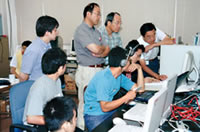TOP > Topics > 2002 > The 2nd Series of Scientific Balloon Experiments in 2002
![]()
The 2nd Series of Scientific Balloon Experiments in 2002
The 2nd series of scientific experiments in 2002 was conducted at Sanriku Balloon Center from August 27 through September 13, 2002. A total number of 4 scientific balloons was launched including two BT5, one B5 and one B80.
The purpose of B80-8 was to collect a large amount of stratospheric atmosphere using a cryogenic sampling system. Approx. 20-litre air sample on an atmospheric-pressure basis was successfully collected at each of 11 almost-evenly spaced points at different altitudes between 15 and 34.5km. The sampled air will go to the universities and institutes concerned and will be measured for density and isotopes of trace constituents of the stratosphere. It is expected that the data obtained will contribute to solving environmental issues such as global warming and understanding the atmospheric circulation and the photochemical reaction process in the stratosphere.

BT5-23 was launched to observe the vertical ozone distribution in the stratosphere using an optical ozone sonde. This year, a new observation instrument was developed, equipped with much higher resolution that was realized by enhancing the data transfer rate and empowered with high-precision measuring of GPS-borne data such as location, altitude and wind velocity. The performance of this new instrument was verified, and data on the vertical distribution of ozone density up to the altitude of 39km was successfully obtained through concurrent observations via both conventional and new instruments.
B5-138 was launched to verify the flight performance of the auto level control system that works to maintain the balloon altitude at a certain level. This system will be loaded into a balloon in 2002's Antarctic orbiting balloon experiments as a flight controller for 20 days up to one month. The system’s performance was verified in the simulated sunset conditions that were produced several times by controlling an air release valve during the flight, as well as at real sunset.
Launched to observe the vertical distribution of nitrogen dioxide and ozone density in the troposphere and stratosphere, BT5-21 successfully obtained the ultraviolet spectrum of the sun. Observations started right after the balloon entered level flight and were carried out by orienting the direction of the gondola to the sun and tracking the sun by making adjustments to downward and upward angles of observation instruments until the sunset up in the sky. It is expected that further downscaling and cost saving of the system will enable steady observation of nitrogen oxide and other trace constituents.
This experiment completes a series of scientific balloon experiments scheduled for 2002. I would like to extend my deep gratitude to everyone involved.
December 24, 2002




